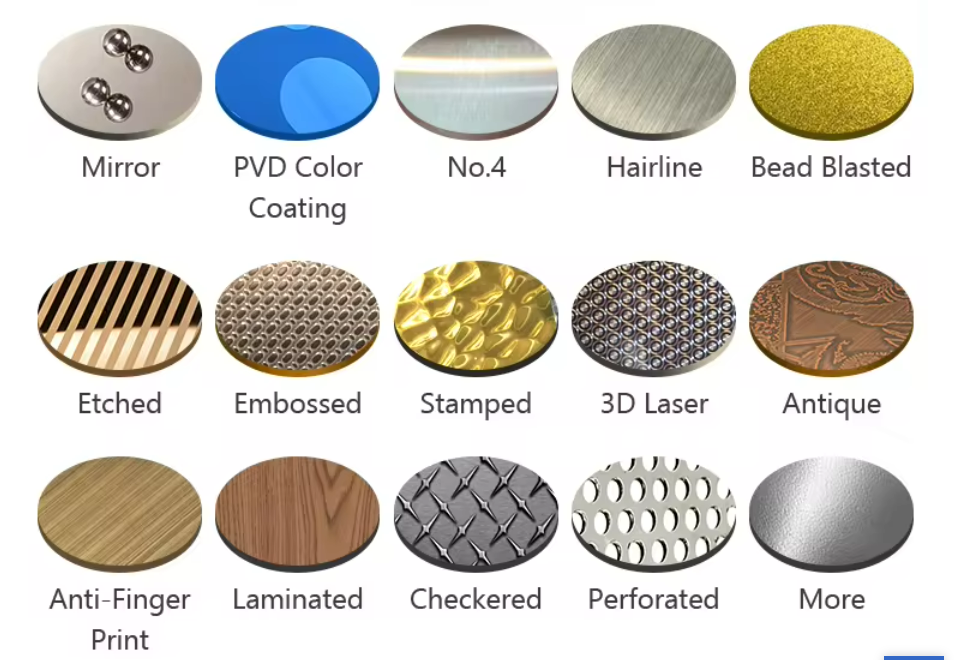In the global marketplace, the demand for high-quality, durable, and aesthetically pleasing materials is ever-increasing. One such material that has gained significant attention is PVD coated stainless steel. But what is PVD finished stainless steel, and why should global buyers consider it for their projects? Let’s delve into the details.
PVD Coated Stainless Steel refers to stainless steel that has been treated with a Physical Vapor Deposition (PVD) coating. This advanced process involves vaporizing a solid material in a vacuum chamber and then depositing it onto the stainless steel surface. The result is a thin, durable, and aesthetically pleasing layer that enhances the properties of the stainless steel.

PVD stands for Physical Vapor Deposition, a state-of-the-art coating process that involves the application of thin film layers onto a substrate—in this case, stainless steel. This process takes place in a vacuum chamber, where a solid material is vaporized and then condensed onto the stainless steel surface. The result is a highly durable, corrosion-resistant, and visually appealing coating that enhances the inherent properties of stainless steel.
The PVD coating equipment of stainless steel strips suppliers usually consists of a vacuum chamber, a target material, a gas supply system, a heating system and a control system. The vacuum chamber ensures that the coating process is carried out in a low-pressure environment to reduce the interference of impurities; the target material provides the coating material; the gas supply system controls the flow of the reaction gas; the heating system adjusts the temperature to optimize the coating adhesion; and the control system accurately manages the entire coating process. The key factors that affect product quality include vacuum, target purity, gas flow and temperature control. High-quality PVD coating products usually come from equipment with high vacuum, precise control and high-purity targets.
Enhanced Durability: PVD coatings significantly increase the hardness and wear resistance of stainless steel. This makes it an ideal choice for applications that require long-lasting performance, such as in the automotive, aerospace, and construction industries.
Corrosion Resistance: Stainless steel is already known for its resistance to rust and corrosion. PVD coating further enhances this property, making it suitable for use in harsh environments, including marine and industrial settings.
Aesthetic Appeal: One of the standout features of PVD coated stainless steel is its ability to achieve a wide range of colors and finishes. From sleek metallic hues to vibrant gold tones, PVD coatings can be customized to meet specific design requirements, making it a popular choice for architectural and interior design applications.
Eco-Friendly Process: The PVD coating process is environmentally friendly, producing minimal waste and using no harmful chemicals. This aligns with the growing global emphasis on sustainable and green manufacturing practices.
Cost-Effective: While the initial cost of PVD coating may be higher than traditional methods, the long-term benefits—such as reduced maintenance and replacement costs—make it a cost-effective solution for many industries.
1. PVD technology is an environmentally friendly coating method. It does not use harmful chemicals and does not produce toxic waste or by-products. In contrast, traditional chemical plating methods may involve the use and handling of harmful chemicals, posing a potential threat to the environment and the health of operators.
2. PVD (Physical Vapor Deposition) technology vaporizes and deposits coating materials onto the surface of stainless steel through a physical process. This method is able to control the thickness and uniformity of the coating at the nanometer level, ensuring high quality and consistency of the coating. In contrast, traditional chemical plating methods may result in uneven coating thickness and unstable quality.
Gold PVD Coating refers to the application of a gold-colored layer onto a substrate, typically stainless steel, using the Physical Vapor Deposition (PVD) process. This advanced technique involves vaporizing a gold-colored material in a vacuum chamber and then depositing it onto the surface, resulting in a thin, durable, and visually appealing coating. Gold PVD coating is widely used in jewelry, watches, consumer electronics, and decorative architectural elements, offering a perfect blend of beauty and performance.
Many people search this topic. But the term “plated” in this context is somewhat of a misnomer, as traditional plating involves electrochemical processes, whereas PVD is a physical vaporization technique. However, the end result is similar in that a new layer is added to the surface of the stainless steel. PVD plated stainless steel is commonly used in industries such as architecture, consumer electronics, automotive, and jewelry, where both aesthetic quality and durability are paramount.
Hot topics that may interest you:
Which is more expensive 304 or 316 stainless steel
Which is stronger 304 or 316 stainless steel
What's the difference between 304 and 316 stainless steel
409 stainless steel vs 304 stainless steel
Crystal structure of stainless steel
How to gold plate stainless steel

College degree, Internation trade Major of CHANGSHA ZHONGSHANG FOREIGN LANGUAGE UNIVERSITY.
Professinal exporting manager of NORMANDY METAL INDUSTRY CO.,LTD.
18 years working experience in STAINLESS STEEL MATERIALS INDUSTRY.



